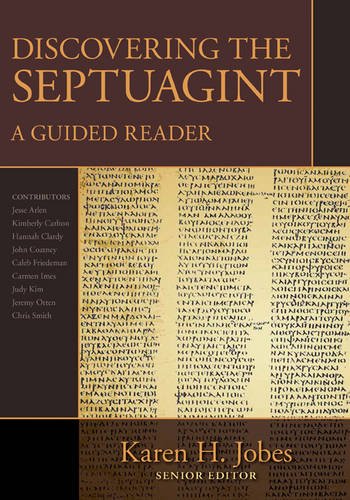At long last Karen Jobes’s Discovering the Septuagint: A Guided Reader, has been published by Kregel Academic. The TL;DR version of my review is: while the resource has a few noticeable flaws (easily fixable for a second edition), its addition to the world of Greek reading and Septuagint studies is long overdue.
Below is a longer review of the book, in what I hope will be easy-to-scan Q & A format.
What books of the LXX are covered?
There are ten, intended to “give readers a taste of different genres, an experience of distinctive Septuagintal elements, and a sampling of texts later used by writers of the New Testament” (9). Discovering the Septuagint treats nearly 700 verses from:
- Genesis (80 verses)
- Exodus (79 verses)
- Exodus 20:1–21 // Deuteronomy 5:6–21 (10 Commandments)
- Ruth (85 verses)
- Additions to Greek Esther (73 verses)
- Psalms (67 verses)
- Hosea (56 verses)
- Jonah (48 verses)
- Malachi (55 verses)
- Isaiah (81 verses)
For whom is this book?
Jobes says it “contains everything needed for any reader with three semesters of koine Greek to succeed in expanding their horizons to the Septuagint” (8). I think this assessment is right, as I found the book easy to understand (though I’ve had more than three semesters of Greek).
How is the book structured?
Each LXX book has a short introduction. Then there is the passage, verse by verse, with the Greek text re-printed in full. Under each verse are word-by-word and phrase-by-phrase comments on the vocabulary, usage, syntax, translation from Hebrew (the book is strong here), and so on. Following each passage is the NETS (English translation). The end of the book has a three-page, 33-term glossary and a two-page “Index of New Testament LXX Citations” for the books included in the reader.
What does a sample entry look like?
Here’s Jonah 4:6:
What’s commendable about Discovering the Septuagint?
It shouldn’t go without saying that the very existence of this resource is a boon to Greek readers. There is Conybeare and Stock, as well as some passages in Decker’s Koine Greek Reader, but readers of the Septuagint have far fewer resources than readers of the Greek New Testament.
The margins are plenty wide for students to jot down their own parsings, translations, and notes.
Notes on the verses are often answers to questions I’ve had as I’ve read the Greek text. In this sense the reader is a great guide. For example, here is a comment from Genesis 1:4:
ἀνὰ μέσον . . . ἀνὰ μέσον | Idiomatic prep phrase, “between.” This is a Hebraism, so there is no need to translate the second of the pair as NETS does.
And another helpful nugget from Genesis 1:11:
κατὰ γένος | Prep + neut sg acc (3rd dec) noun, γένος, kind. Remember the nom and acc forms are identical in this paradigm. Agrees with and modifies σπέρμα.
Whether or not a fourth semester Greek student should remember that nominative and accusative forms are identical in the third declension is another issue. That the reader reminds me as much is welcomed.
What is lacking?
The glued binding doesn’t do justice to a book like this, but that seems to be the way many publishers have gone recently, even with reference works in biblical studies.
Parts of the book feel under-edited or rushed to print:
- a few typos (missing periods, etc.)
- referring to the Rahlfs-Hanhart text as a “critical edition of the Septuagint” (9), which is technically true, but potentially misleading, as “semi-critical” is better (text criticism is not a real concern of the book)
- a peppering of vague statements like this one on “the image of God” in Genesis 1:26: “See a commentary or study Bible” (31)
- the typesetting on the epsilon just seems off to me. I’ve tried to convince myself it’s just me, but I haven’t since been able to unsee what just looks like a flattened ε or a backwards three, rather than an actual Greek letter:
By contrast, look at the letter in this screenshot, taken from Accordance Bible Software:
The layout and Greek font are nice otherwise! (Though a couple times in the typesetting of the book, a letter from another language intrudes mid-word.)
- Introductory issues are quite sparse–whether in the introduction to the Greek of the Septuagint itself (just two pages) or in the introductions to books. I would have liked it if the contributing writers had offered more for each book–even three or four pages would have gone further than the one or two that are here.
This last point deserves just a couple more lines. A number of the introductions adapt or “abstract” their text from the NETS book introductions, which readers could easily enough have found on their own. In some ways the book introductions read just like exam study guides you might have made yourself for a grad-level class on the Septuagint. That may be, in fact, how they started! (Jobes is chief overseer of the book, with many contributors.) This does not make the introductions not valuable, but it will probably leave readers wishing for more detail.
All in all, Discovering the Septuagint is worth owning. The number of times I’ve gotten grammatical or morphological help from the comments far outweighs any of the volume’s weaknesses. And there is a lot of Greek help to be had here. I’ll be making repeated use of this book by Jobes and company, and am glad it’s finally on the market.
Discovering the Septuagint is available from Amazon, as well as from Kregel.
Thanks to Kregel for sending the review copy, provided to me so I could write about the book, but with no expectation as to the content of my review.





Reblogged this on Talmidimblogging.